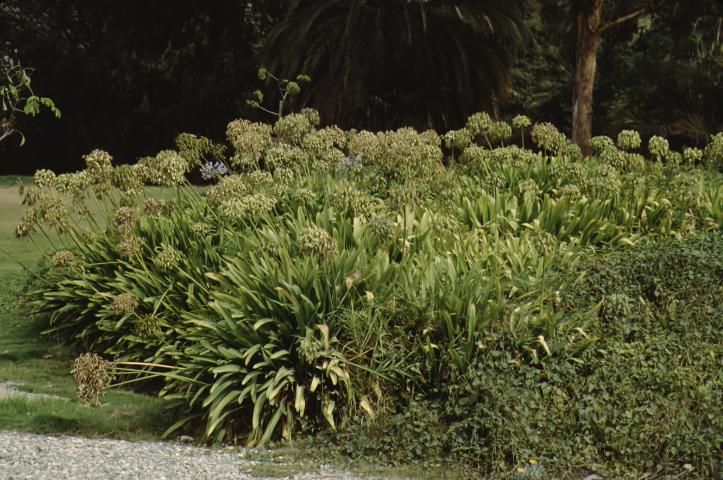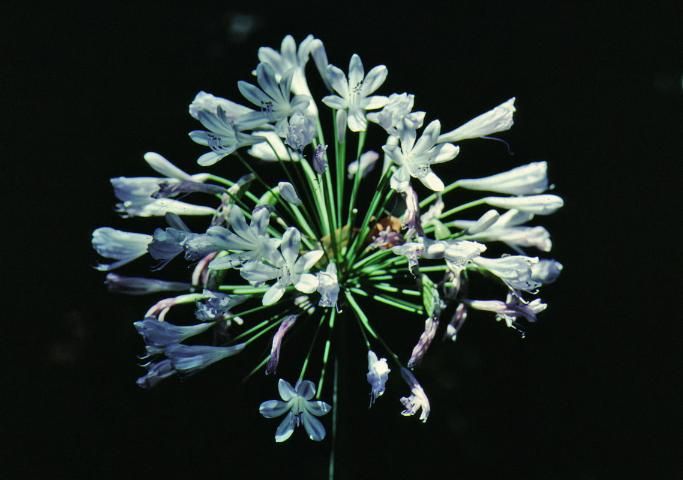Introduction
Clusters of large, blue, funnel-shaped flowers appear atop long stalks in summer and early fall, rising above the coarse, strap-like, green leaves. Flowers make a wonderful display in mass plantings. They can also be used as accents in a small garden or by the patio.

Credit: Edward F. Gilman, UF/IFAS

Credit: Edward F. Gilman, UF/IFAS
General Information
Scientific name: Agapanthus orientalis
Pronunciation: ag-uh-PANTH-us or-ee-en-TAY-liss
Common name(s): Agapanthus, African lily, lily of the Nile
Family: Amaryllidaceae
Plant type: perennial; herbaceous
USDA hardiness zones: 9 through 11 (Figure 3)

Planting month for zone 9: year-round
Planting month for zone 10 and 11: year-round
Origin: not native to North America
Invasive potential: not known to be invasive
Uses: mass planting; container or above-ground planter; groundcover; accent; edging; attracts hummingbirds; suitable for growing indoors
Availability: somewhat available, may have to go out of the region to find the plant
Description
Height: 2 to 4 feet
Spread: 1 to 2 feet
Plant habit: upright
Plant density: moderate
Growth rate: moderate
Texture: medium
Foliage
Leaf arrangement: alternate
Leaf type: simple
Leaf margin: entire
Leaf shape: linear
Leaf venation: parallel
Leaf type and persistence: evergreen
Leaf blade length: 8 to 12 inches
Leaf color: green
Fall color: no fall color change
Fall characteristic: not showy
Flower
Flower color: blue; lavender; purple
Flower characteristic: summer-flowering
Fruit
Fruit shape: no fruit
Fruit length: no fruit
Fruit cover: no fruit
Fruit color: no fruit
Fruit characteristic: no fruit
Trunk and Branches
Trunk/bark/branches: not applicable
Current year stem/twig color: not applicable
Current year stem/twig thickness: not applicable
Culture
Light requirement: plant grows in part shade/part sun
Soil tolerances: occasionally wet; slightly alkaline; clay; sand; acidic; loam
Drought tolerance:
Soil salt tolerance: unknown
Plant spacing: 18 to 24 inches
Other
Roots: not applicable
Winter interest: no special winter interest
Outstanding plant: plant has outstanding ornamental features and could be planted more
Pest resistance: no serious pests are normally seen on the plant
Use and Management
Growing in full sun or partial shade, Agapanthus is usually left undisturbed for several years and will form a large clump, making an attractive groundcover or accent plant. Agapanthus prefers moist, organic soil conditions but can endure drought once established. Plant about 18 to 24 inches apart for a thick groundcover effect.
Available cultivars include: 'Albus,' white flowers; 'Flore Pleno,' double flowers; 'Variegatus,' with striped leaves; and 'Nanus,' a dwarf, compact form.
Propagation is by division or seed.
Disease-resistant selections are available for humid climates.
Problems include chewing insects, maggots, and borers.
Design Considerations
The strap-like leaves and large blue flowers of the agapanthus make it perfect for highly visible spaces in the landscape. Use with plants that are softer with small foliage and mounding or spreading forms. Dark green and/or burgundy foliage in the companion plants will highlight the clusters of blue flowers and soft green of the leaves. New agapanthus cultivars also have white, dark blue, and violet-blue flowers. When pairing with other flowering plants use white, and warm colors such as pinks and corals and soft yellows and light orange with the blue-flowered agapanthus. The white-flowered variety can be used with any other color to brighten the space.
Pests and Diseases
Botrytis can devastate a planting, especially in humid climates in the eastern US. Try the disease-resistant selections in the East.